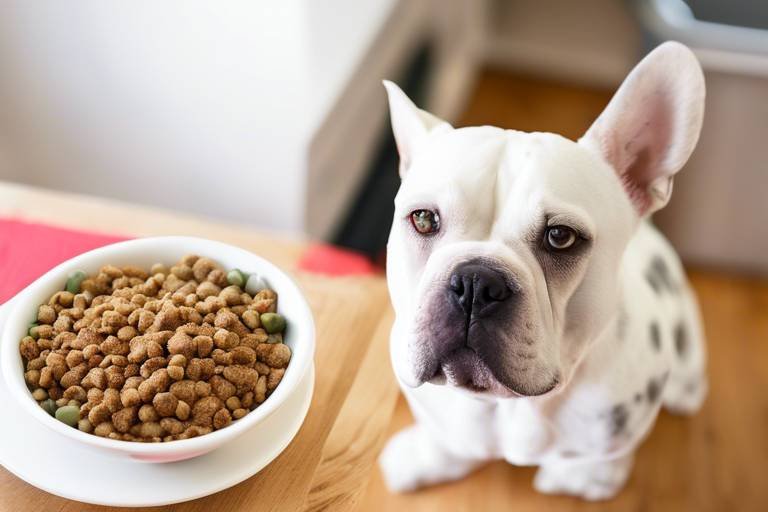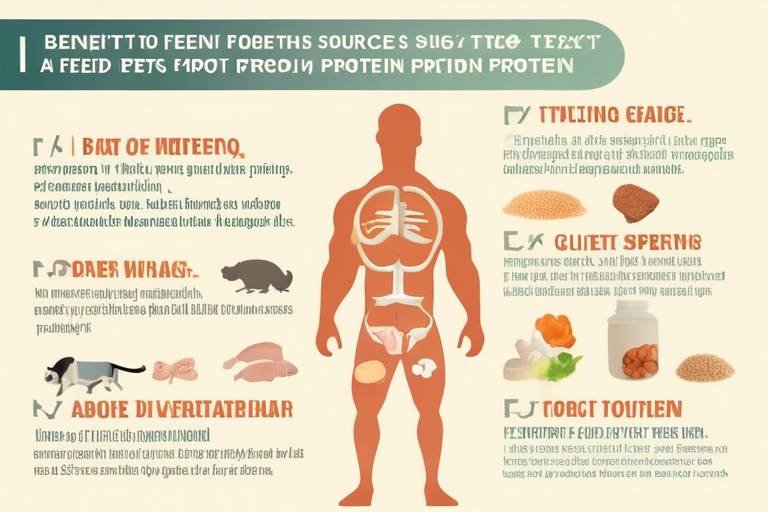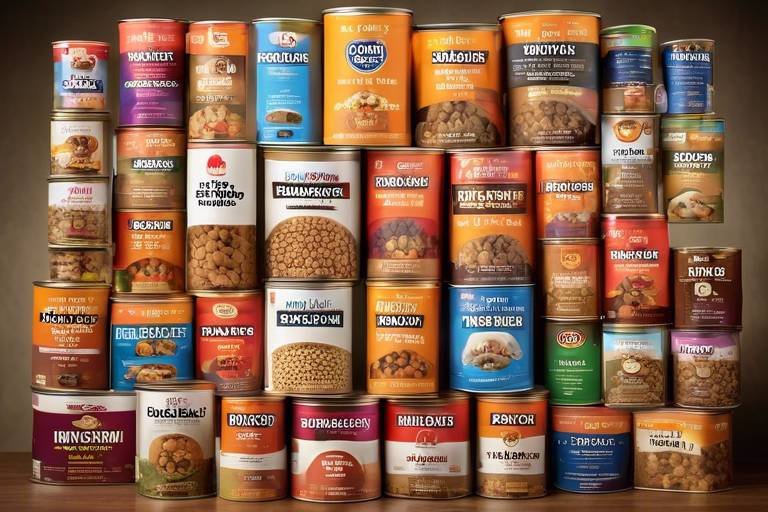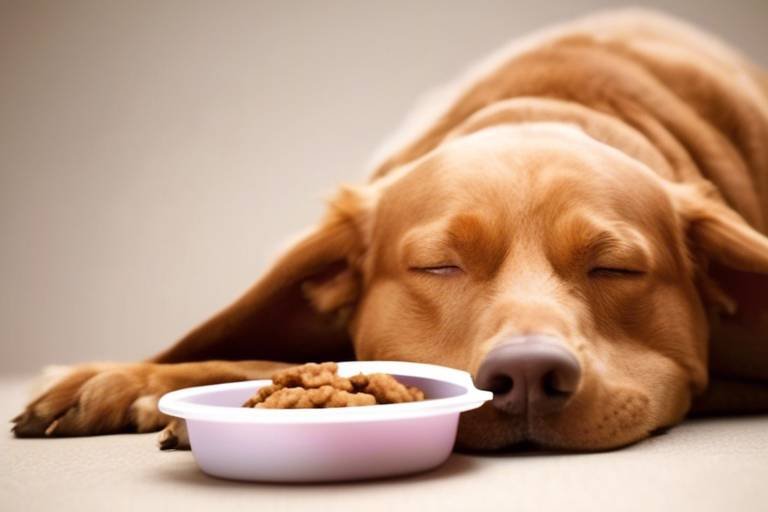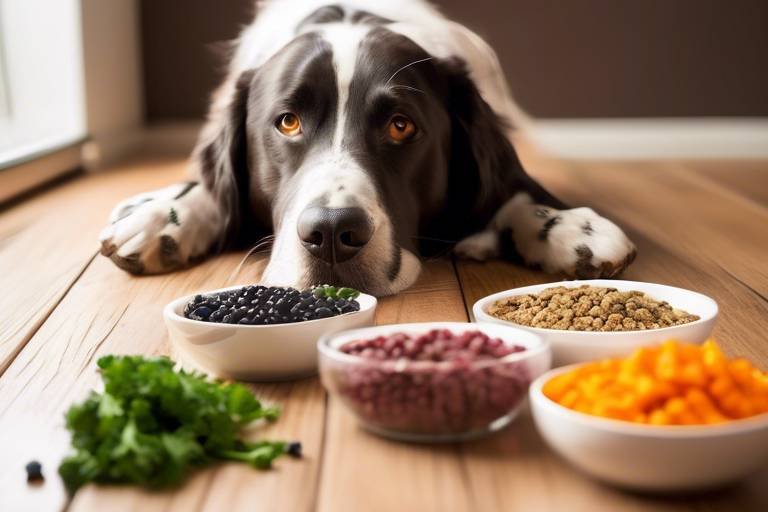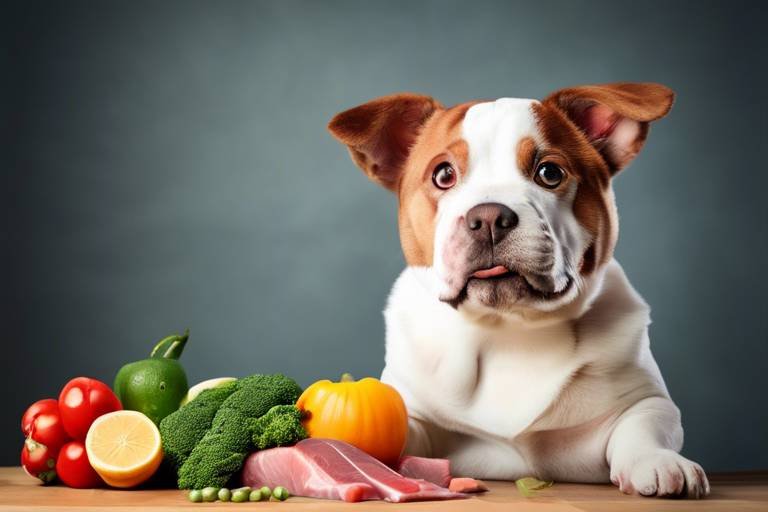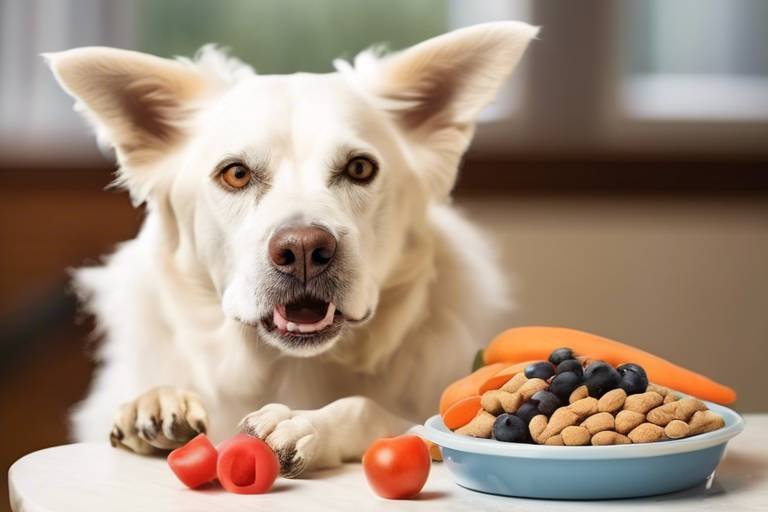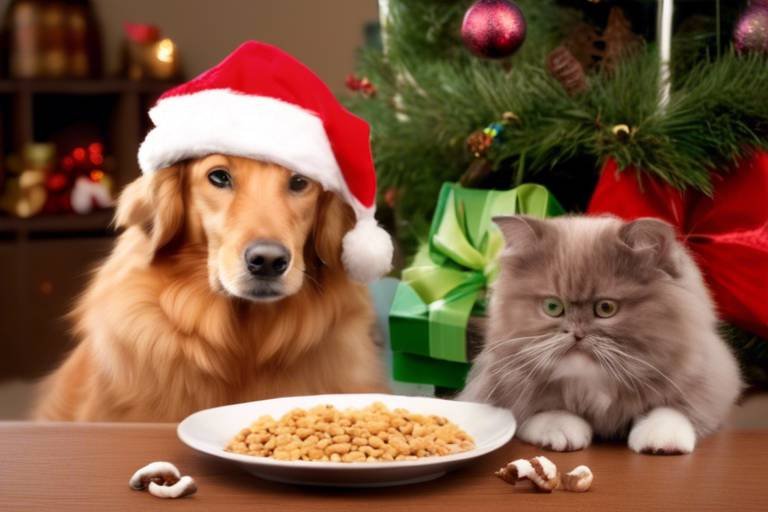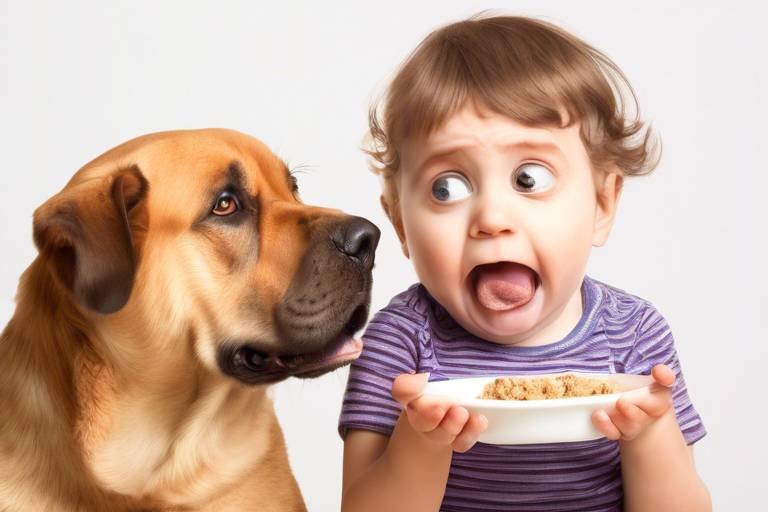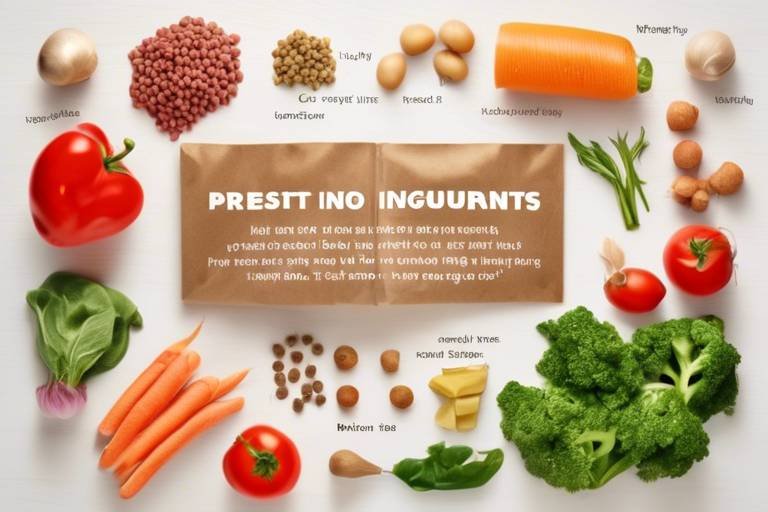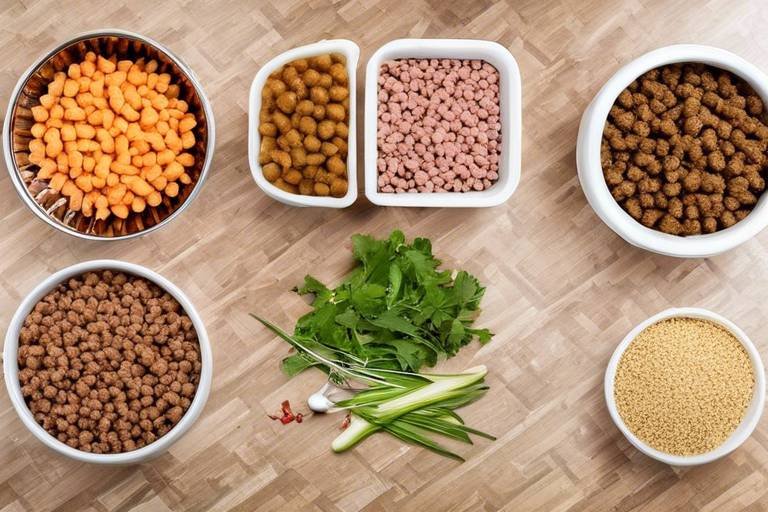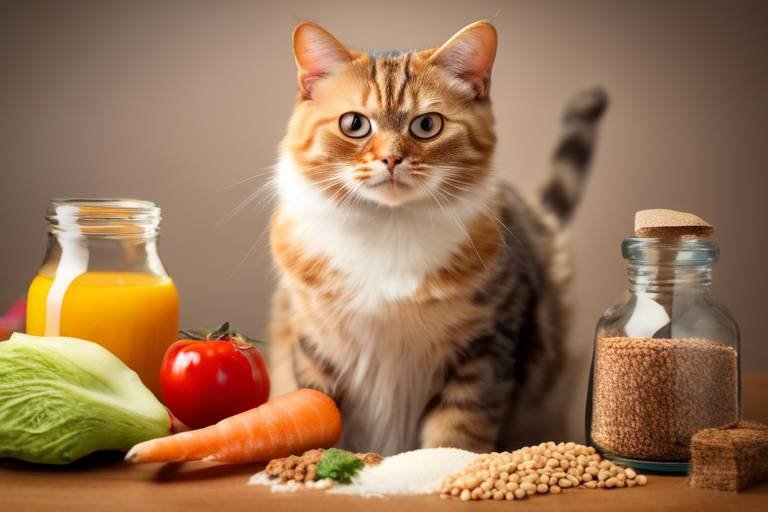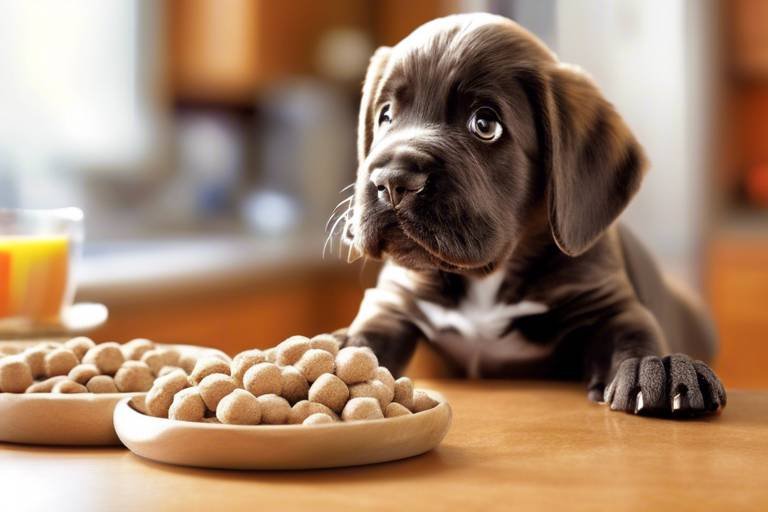How to Balance Homemade Pet Meals
Creating balanced homemade meals for your furry friends is not just a culinary adventure; it’s a commitment to their health and happiness. With the rising trend of pet owners opting for homemade diets, it’s essential to understand that not all meals are created equal. Just like us, pets require a variety of nutrients to thrive, and striking the right balance can sometimes feel like a daunting task. But don’t worry! This article is here to guide you through the essentials of crafting meals that are not only tasty but also packed with the necessary nutrients your pets need.
Imagine your pet as a little engine that needs the right fuel to run smoothly. If you put in the wrong kind of fuel, the engine might sputter or even break down. Similarly, improper nutrition can lead to a host of health issues for your pets, including obesity, digestive problems, and even more severe conditions. By understanding how to balance their meals, you’re not just feeding them; you’re investing in their long-term health and well-being.
One of the first steps in this journey is to recognize the importance of a well-rounded diet. Just like a balanced plate for humans includes proteins, carbohydrates, and fats, your pet’s meals should reflect this balance too. It’s not just about filling their bowl; it’s about filling it with the right ingredients. Think of it as creating a masterpiece where each ingredient plays a vital role in the final product. From proteins that build their muscles to fats that keep their skin shiny and healthy, every component matters.
In the sections that follow, we will delve deeper into the key nutrients your pets need and how to incorporate them into their diet. We’ll explore the various sources of proteins, the importance of fats and carbohydrates, and even share some easy-to-follow recipes that cater to different dietary needs. So, grab your apron and let’s embark on this exciting journey of homemade pet meals together!
Understanding the role of balanced nutrition in your pet's health is crucial. A well-rounded diet can lead to a longer, happier life for your pet. Just think about how you feel after eating a balanced meal versus junk food. The same goes for our pets! A diet rich in essential nutrients can improve their energy levels, enhance their coat's shine, and even boost their immune system.
On the flip side, improper nutrition can have dire consequences. Pets fed a diet lacking in essential nutrients may experience growth issues, lethargy, and a higher susceptibility to diseases. It’s like sending them into battle without armor. Therefore, as a responsible pet owner, it’s vital to ensure that their meals are not only delicious but also nutritionally complete.
Every pet needs a variety of nutrients to stay healthy, and understanding these key components will help you create a balanced meal plan. The essential nutrients include:
- Proteins: The building blocks for growth and repair.
- Fats: Essential for energy and healthy skin.
- Carbohydrates: A source of energy and fiber.
- Vitamins: Crucial for various bodily functions.
- Minerals: Important for bone health and metabolic processes.
Incorporating these nutrients into your pet's meals can be simple once you know what to look for. For instance, lean meats, fish, and eggs are excellent protein sources, while vegetables and grains can provide necessary carbohydrates and fiber. By mixing and matching these ingredients, you can create meals that are not just balanced but also exciting for your pet!
Now that we’ve covered the basics of pet nutrition, let’s get into the fun part – cooking! Below, we’ll share some delicious and nutritious homemade meal recipes tailored for both dogs and cats.
Dogs love variety just as much as we do! Here are a couple of easy recipes that ensure they get a balanced meal:
1. Chicken and Rice Delight - Ingredients: 1 cup cooked chicken, 1 cup brown rice, 1 cup carrots, 1 cup peas - Instructions: Mix all ingredients and serve warm. 2. Beef and Veggie Stew - Ingredients: 1 lb ground beef, 2 cups sweet potatoes, 1 cup green beans, 1 cup carrots - Instructions: Cook beef, add vegetables, simmer until tender.
Cats can be a bit more finicky, but they also deserve delicious meals! Here are some recipes tailored just for them:
1. Tuna and Pumpkin Mash - Ingredients: 1 can tuna, 1/2 cup pumpkin puree, 1/4 cup peas - Instructions: Blend until smooth and serve. 2. Chicken Liver Pâté - Ingredients: 1 cup chicken livers, 1/4 cup chicken broth, 1 tbsp olive oil - Instructions: Cook livers, blend with broth and oil until creamy.
Q: Can I feed my pet a vegetarian diet?
A: Yes, but it’s crucial to ensure that all essential nutrients are included, particularly proteins and certain vitamins.
Q: How do I know if my pet is getting enough nutrients?
A: Regular vet check-ups and observing your pet's energy levels, coat condition, and overall health can provide insights.
Q: Are there any foods I should avoid?
A: Yes, certain foods like chocolate, onions, and grapes are toxic to pets and should be avoided at all costs.

The Importance of Nutrition
When it comes to the health and happiness of our furry friends, nutrition is paramount. Just like how we need the right balance of foods to thrive, our pets require a well-rounded diet to ensure they remain energetic, playful, and free from diseases. A balanced diet not only supports their physical health but also enhances their mental well-being. Imagine fueling a car with the wrong type of fuel; it wouldn't run efficiently, right? The same goes for our pets. If they lack essential nutrients, it can lead to a plethora of health issues, from obesity and diabetes to heart disease and poor coat condition.
One of the most significant benefits of providing a balanced diet is the prevention of chronic diseases. A diet rich in essential nutrients can help strengthen your pet's immune system, making them less susceptible to illnesses. Conversely, improper nutrition can lead to deficiencies that may cause serious health problems. For example, a lack of certain vitamins can lead to skin issues, while insufficient protein can affect muscle development and energy levels.
Furthermore, a proper diet can influence your pet's behavior. Pets that receive a balanced diet are often more calm and focused, while those on a poor diet may exhibit hyperactivity or lethargy. It's fascinating how what goes into their bowls can affect their mood and behavior!
So, what exactly constitutes a balanced diet for pets? It typically includes a mix of proteins, fats, carbohydrates, vitamins, and minerals. Each of these nutrients plays a unique role in your pet's health:
- Proteins: Essential for growth, repair, and energy.
- Fats: Provide energy and support cell function.
- Carbohydrates: A source of energy and aid in digestion.
- Vitamins: Crucial for various metabolic processes.
- Minerals: Important for bone health and other bodily functions.
In summary, the importance of nutrition in your pet's life cannot be overstated. By ensuring they get a balanced diet, you are investing in their long-term health and happiness. Remember, a healthy pet is a happy pet, and it all starts with what they eat!

Key Nutrients for Pets
When it comes to ensuring our furry friends lead healthy and happy lives, nutrition plays a pivotal role. Just like humans, pets require a balanced diet to thrive. This means their meals should include a variety of essential nutrients that cater to their unique biological needs. The key nutrients for pets fall into several categories: proteins, fats, carbohydrates, vitamins, and minerals. Each of these nutrients serves a specific purpose in maintaining your pet's health and well-being.
Let’s dive deeper into these crucial components. Proteins are often referred to as the building blocks of life. They are essential for growth, tissue repair, and overall body function. Without adequate protein, pets can face issues such as muscle loss and a weakened immune system. On the other hand, fats are not just a source of energy; they also support cell structure and help absorb certain vitamins. Healthy fats, like those found in fish oil, can contribute to a shiny coat and healthy skin.
Carbohydrates, while sometimes viewed as optional, provide a quick source of energy and aid in digestive health. They can be found in grains, vegetables, and fruits. Speaking of fruits and veggies, these are also rich in vitamins and minerals, which are crucial for various bodily functions. For instance, vitamins A and E are important for vision and immune function, while minerals like calcium and phosphorus are key for strong bones and teeth.
To help you understand the balance of these nutrients, here’s a quick overview of their roles:
| Nutrient | Role in Pet Health | Sources |
|---|---|---|
| Proteins | Growth, tissue repair, immune function | Meat, fish, eggs, legumes |
| Fats | Energy, cell structure, vitamin absorption | Fish oil, flaxseed, chicken fat |
| Carbohydrates | Quick energy, digestive health | Grains, vegetables, fruits |
| Vitamins | Various bodily functions | Fruits, vegetables, supplements |
| Minerals | Bone health, nerve function | Meat, dairy, leafy greens |
Understanding these nutrients and their sources is the first step in crafting meals that will keep your pets healthy. Remember, just as we wouldn’t want to eat the same meal every day, our pets also benefit from a varied diet. This not only keeps their meals interesting but also ensures they receive a comprehensive range of nutrients. When preparing homemade meals, it’s essential to strike a balance among these nutrients to meet your pet’s specific needs, which can vary based on their age, breed, and activity level.
So, the next time you're whipping up a meal for your furry companion, think about how you can incorporate these vital nutrients. By doing so, you're not just feeding them; you're investing in their health and happiness!
- What should I include in my pet's homemade meals? Aim for a mix of proteins, healthy fats, carbohydrates, vitamins, and minerals.
- How can I ensure my pet's meals are balanced? Consult with a veterinarian or a pet nutritionist for tailored advice.
- Can I use leftovers to prepare my pet’s meals? Yes, but ensure they are safe for pets and balanced with other nutrients.
Proteins: The Building Blocks
When it comes to your pet's diet, proteins are the unsung heroes. They are not just another ingredient; they are the fundamental building blocks that your furry friend needs for growth, repair, and overall health. Think of proteins as the bricks in a house. Without a solid foundation, everything else crumbles. Just like us, pets require a balanced intake of proteins to maintain their energy levels, support their immune systems, and keep their muscles strong.
So, what are the best sources of protein for your pets? You have a variety of options, ranging from animal proteins to plant-based proteins. Animal proteins, such as chicken, beef, and fish, are often considered complete proteins because they contain all the essential amino acids your pet needs. On the other hand, plant proteins, like lentils and beans, can also contribute to your pet's protein intake, but they may lack certain amino acids. It's crucial to understand the differences between these sources to make informed choices for your pet's meals.
To ensure your pet is getting enough protein, you need to consider several factors, including their age, weight, and activity level. For instance, a growing puppy or kitten will require significantly more protein than a sedentary adult pet. If you're wondering how to calculate your pet's specific protein needs, there are some guidelines you can follow. Generally, a dog should consume about 18% to 25% of their daily caloric intake from protein, while cats need around 25% to 30%. To make it easier, you can use the following formula:
| Pet Type | Protein Percentage | Daily Protein Requirement (grams) |
|---|---|---|
| Dog (Adult) | 18% - 25% | Based on weight and activity level |
| Cat (Adult) | 25% - 30% | Based on weight and activity level |
| Puppy/Kittens | Up to 30% | Based on weight and growth stage |
By understanding your pet's unique protein needs, you can craft a meal plan that supports their health and vitality. Remember, it's not just about throwing in some meat; it’s about creating a well-rounded diet that includes a variety of protein sources. This approach ensures that your pet receives all the essential amino acids they need to thrive.
Incorporating proteins into your homemade meals can be fun and rewarding. Try mixing different protein sources to keep things interesting! For instance, you could prepare a chicken and lentil stew or a beef and vegetable medley. Not only will your pets love the flavors, but you'll also be providing them with a comprehensive nutritional profile. In the end, a little creativity in the kitchen can go a long way in ensuring your pets lead a healthy and happy life.
- How much protein does my pet need? The amount of protein varies based on your pet's age, weight, and activity level. Consult with your vet for personalized recommendations.
- Can I use plant proteins for my pet? Yes, but ensure they are complemented with animal proteins to provide complete nutrition.
- Is raw protein safe for pets? Raw diets can be controversial; always consult with your vet before making any drastic changes to your pet’s diet.
Animal vs. Plant Proteins
When it comes to feeding our beloved pets, one of the most hotly debated topics is the source of their protein. It's like choosing between a juicy steak and a hearty quinoa salad for dinner! Both have their merits, but understanding the differences between animal and plant proteins is crucial for creating a balanced diet. Animal proteins, which include meats, fish, and dairy, are often considered the gold standard for pet nutrition. They are packed with essential amino acids that are vital for your pet's growth and overall health. Think of them as the building blocks that help your furry friend build muscle, repair tissues, and maintain a healthy immune system.
On the flip side, we have plant proteins, which are derived from sources like beans, lentils, and grains. While they can also provide some amino acids, they often lack one or more of the essential amino acids that pets need. It's a bit like trying to build a house with missing bricks; it just doesn’t hold up as well! However, plant proteins can still play a valuable role in your pet's diet, especially when combined with animal proteins. This combination can create a more rounded nutritional profile and can be particularly beneficial for pets with specific dietary restrictions or allergies.
So, how do you decide what’s best for your pet? It largely depends on their individual needs. For example, dogs are omnivores and can thrive on a diet that includes both animal and plant proteins. Cats, however, are obligate carnivores, meaning they require a higher percentage of animal protein in their diet to meet their nutritional needs. It’s essential to consult with your veterinarian to determine the right balance for your pet based on their age, weight, and activity level.
To help visualize the differences, let’s look at a quick comparison:
| Type of Protein | Source | Benefits |
|---|---|---|
| Animal Protein | Meat, Fish, Dairy | High in essential amino acids, easily digestible, supports muscle development |
| Plant Protein | Beans, Lentils, Grains | Good for fiber, lower in fat, can help with allergies when combined with animal proteins |
In conclusion, both animal and plant proteins have their place in your pet's diet. The key is to strike a balance that meets their specific nutritional needs. Remember, it's not just about filling their bowl; it's about nourishing their body and ensuring they lead a happy, healthy life. Always keep an eye on their health and consult your vet when in doubt!
Calculating Protein Needs
Calculating your pet's protein needs is a crucial step in ensuring they receive a balanced diet. Just like humans, pets have specific nutritional requirements that vary based on several factors, including age, weight, and activity level. Imagine trying to fuel a race car with the wrong type of gas; it simply won't perform at its best! Similarly, providing your pet with the right amount of protein is essential for their growth, energy, and overall health.
To start, you'll want to determine your pet's weight in kilograms. If you're more comfortable with pounds, you can convert it by dividing the weight by 2.2. Once you have your pet's weight, you can use a simple formula to calculate their protein needs:
| Activity Level | Protein Requirement (grams per kg of body weight) |
|---|---|
| Inactive (senior pets) | 1.0 - 1.5 g |
| Moderately Active | 1.5 - 2.0 g |
| Highly Active (working dogs) | 2.0 - 3.0 g |
For example, if you have a moderately active dog weighing 20 kg, you would calculate their protein requirement as follows:
20 kg x 1.5 g/kg 30 grams of protein per day
This calculation provides a general guideline, but keep in mind that individual needs can vary. Factors such as health conditions, breed, and even specific dietary preferences play a role in determining the exact amount of protein your pet requires. It's always a good idea to consult with your veterinarian to tailor a diet that best suits your furry friend.
In addition to the total protein requirement, it's essential to consider the sources of protein in your pet's diet. Not all proteins are created equal! Animal proteins, such as chicken, beef, and fish, are generally more complete and digestible compared to plant-based proteins. However, a combination of both can also provide a balanced approach, especially for pets with specific dietary restrictions.
Finally, remember that protein isn't the only nutrient your pet needs. A well-rounded diet includes fats, carbohydrates, vitamins, and minerals. Think of it like a well-balanced orchestra; each instrument plays a vital role in creating a beautiful symphony of health for your pet!
- How can I tell if my pet is getting enough protein? Look for signs of a healthy coat, energy levels, and overall vitality. If your pet appears lethargic or has a dull coat, it may be time to reassess their diet.
- Can I use plant-based proteins for my pet? Yes, but it's important to ensure that these proteins are complemented with animal proteins to provide a complete amino acid profile.
- What if my pet has specific health issues? Always consult with your veterinarian before making any significant changes to your pet's diet, especially if they have underlying health conditions.
Fats and Carbohydrates
When it comes to your pet's diet, are just as important as proteins. These macronutrients not only provide energy but also support various bodily functions. Think of fats as the fuel that keeps your pet's engine running smoothly. They are essential for maintaining healthy skin and a shiny coat, while carbohydrates serve as a quick energy source, especially for our more active furry friends. But how do you know which fats and carbohydrates are best for your pet?
First, let’s look at fats. Not all fats are created equal! Healthy fats, such as omega-3 and omega-6 fatty acids, can be found in fish oil, flaxseed oil, and certain nuts. These fats are crucial for reducing inflammation and supporting brain health. On the other hand, unhealthy fats, like those found in processed foods, can lead to obesity and other health issues. Therefore, when preparing homemade meals, it's important to choose high-quality fat sources. A good rule of thumb is to include about 10-15% of healthy fats in your pet's diet, depending on their energy needs.
Now, let’s turn our attention to carbohydrates. They often get a bad rap, but they can be a valuable part of your pet's diet when chosen wisely. Whole grains like brown rice and oats, as well as vegetables such as sweet potatoes and peas, provide not only energy but also fiber, which aids digestion. However, it's essential to avoid refined carbohydrates, like white rice or bread, which can spike blood sugar levels and offer little nutritional benefit. A balanced homemade meal should consist of around 30-50% carbohydrates, depending on your pet's activity level.
To help you visualize the ideal balance of fats and carbohydrates in your pet’s diet, refer to the table below:
| Macronutrient | Recommended Percentage | Examples |
|---|---|---|
| Fats | 10-15% | Fish oil, flaxseed oil, chicken fat |
| Carbohydrates | 30-50% | Brown rice, oats, sweet potatoes, peas |
Incorporating the right balance of fats and carbohydrates into your pet's homemade meals can make a significant difference in their overall health. It's like putting premium fuel into a high-performance car; it runs better and lasts longer! So, the next time you’re whipping up a meal for your furry companion, remember to keep these macronutrients in mind. Your pet will not only feel more energetic but will also thrive with a well-rounded diet.
- What types of fats are best for pets? Healthy fats such as omega-3 and omega-6 fatty acids found in fish oil and flaxseed oil are ideal.
- Can pets digest carbohydrates? Yes, pets can digest carbohydrates, but it's crucial to choose whole grains and vegetables for better nutrition.
- How do I know if my pet is getting enough nutrients? Regular vet check-ups and monitoring your pet's weight and energy levels can help you determine if their diet is balanced.

Homemade Meal Recipes
Creating homemade meals for your furry friends can be a rewarding experience, both for you and your pets. Not only does it allow you to control the ingredients, but it also ensures that your pets receive a balanced diet tailored to their specific needs. Whether you have a dog or a cat, the recipes below will help you whip up nutritious meals that they will absolutely love.
Before diving into the recipes, it’s essential to remember that pets have different dietary requirements. For instance, dogs are omnivores and can thrive on a mix of meats, grains, and vegetables, while cats are obligate carnivores, meaning they require a higher proportion of meat in their diets. Understanding these differences will help you create meals that are not only tasty but also healthy.
Here’s a simple yet nutritious recipe for your canine companion:
Chicken and Rice Dog Meal Ingredients: - 1 cup of cooked chicken (shredded) - 1/2 cup of brown rice - 1/2 cup of carrots (chopped) - 1/2 cup of peas (fresh or frozen) Instructions: 1. In a pot, combine the chicken, rice, carrots, and peas. 2. Add 2 cups of water and bring to a boil. 3. Reduce heat and let simmer for about 20 minutes, or until the rice is fully cooked. 4. Allow to cool before serving to your dog.
This recipe is not only easy to prepare but also packed with protein and essential nutrients. Plus, your dog will appreciate the delicious flavors!
Now, let’s not forget our feline friends. Here’s a delectable recipe to keep them purring:
Salmon and Sweet Potato Cat Meal Ingredients: - 1 can of salmon (in water, drained) - 1/2 cup of cooked sweet potato (mashed) - 1/4 cup of peas (fresh or frozen) Instructions: 1. In a bowl, combine the salmon, sweet potato, and peas. 2. Mix well until all ingredients are evenly distributed. 3. Serve at room temperature to your cat.
This meal is rich in omega-3 fatty acids, which are fantastic for your cat’s coat and overall health. Plus, the sweet potato provides a good source of carbohydrates for energy.
When preparing homemade meals for your pets, here are a few tips to keep in mind:
- Consult Your Vet: Always check with your veterinarian before making significant changes to your pet's diet.
- Portion Control: Be mindful of portion sizes to avoid overfeeding.
- Store Properly: Keep leftovers in the fridge and consume them within a few days to ensure freshness.
- Introduce Gradually: If switching to homemade meals, do so gradually to avoid digestive upset.
With these recipes and tips, you can confidently prepare balanced and delicious meals for your pets. Remember, the love and care you put into their meals will not only nourish their bodies but also strengthen your bond with them.
Q: Can I feed my pet only homemade meals?
A: While homemade meals can be nutritious, it’s important to ensure they are balanced and meet all your pet's dietary needs. Consulting with a veterinarian is advisable.
Q: How do I know if my pet is getting enough nutrients?
A: Monitoring your pet’s health, energy levels, and coat condition can provide clues. Regular vet check-ups can also help assess their nutritional status.
Q: Are there any foods I should avoid giving my pets?
A: Yes, certain foods like chocolate, onions, garlic, grapes, and raisins can be toxic to pets. Always research or consult with a vet before introducing new foods.
Recipes for Dogs
When it comes to feeding our furry friends, variety and balance are key. Dogs thrive on a diet that includes a mix of proteins, healthy fats, and carbohydrates. Here are some simple yet nutritious recipes that you can whip up in your kitchen, ensuring your canine companion gets all the essential nutrients they need to stay healthy and happy.
Before we dive into the recipes, it's important to remember that every dog is unique. Factors like age, breed, weight, and activity level play a significant role in determining their dietary needs. Always consult with your veterinarian before making any significant changes to your dog's diet. Now, let’s get cooking!
This classic recipe is easy to prepare and is perfect for dogs with sensitive stomachs. It’s packed with protein and carbohydrates, making it a great choice for everyday meals.
Ingredients: - 1 cup of cooked chicken, shredded - 1 cup of brown rice, cooked - 1/2 cup of carrots, chopped - 1/2 cup of peas - 1 tablespoon of olive oil
Simply mix all the ingredients in a bowl, and serve! The chicken provides high-quality protein, while the rice and veggies offer essential carbohydrates and vitamins.
This recipe is a hearty option that your dog will love. Sweet potatoes are an excellent source of fiber and vitamins, and they complement the beef beautifully.
Ingredients: - 1 pound of ground beef - 1 large sweet potato, peeled and cubed - 1/2 cup of green beans, chopped - 1/4 cup of beef broth (low sodium)
Cook the beef in a skillet until browned, then add the sweet potato and green beans. Pour in the beef broth and let everything simmer until the sweet potatoes are tender. Mash it all together and serve warm. Your dog will be begging for more!
For a different protein source, try this fish recipe. Fish is rich in omega-3 fatty acids, which are great for your dog’s skin and coat.
Ingredients: - 2 fillets of salmon or white fish - 1 cup of quinoa, cooked - 1/2 cup of spinach, chopped - 1/2 cup of carrots, grated
Steam the fish until it’s cooked through, then flake it into pieces. Combine it with quinoa, spinach, and carrots for a complete meal that’s bursting with flavor and nutrients.
This warm and comforting stew is perfect for chilly days. Pumpkin is not only delicious but also packed with fiber, which helps with digestion.
Ingredients: - 1 pound of ground turkey - 1 can of pumpkin puree (not the spiced pie filling) - 1 cup of carrots, diced - 1/2 cup of peas - 2 cups of low-sodium chicken broth
In a large pot, cook the turkey until browned. Add the pumpkin, carrots, peas, and chicken broth. Let it simmer for about 20 minutes, and your dog will have a nutritious stew that warms the belly!
These recipes are not only easy to prepare but also packed with the nutrients your dog needs. You can even mix and match ingredients based on your dog's preferences and dietary restrictions. Just remember to introduce new foods gradually to avoid any digestive upset.
Q: Can I feed my dog homemade meals every day?
A: Yes, as long as the meals are balanced and meet your dog's nutritional needs. It's best to consult with a veterinarian to ensure you're providing a complete diet.
Q: Are there any foods I should avoid giving my dog?
A: Absolutely! Foods like chocolate, grapes, onions, and garlic are toxic to dogs and should be avoided at all costs.
Q: How do I know if my dog is getting enough nutrients?
A: Regular vet check-ups can help monitor your dog's health and nutritional status. Look for signs of a healthy coat, energy levels, and a good weight.
Q: Can I use leftovers in my dog's meals?
A: Yes, but make sure the leftovers are safe for dogs and do not contain any harmful ingredients. Always check with your vet if you're unsure.
Recipes for Cats
Creating homemade meals for your feline friend can be a delightful experience, not just for you but for your cat as well! Cats are obligate carnivores, which means their bodies are designed to thrive on a meat-based diet. However, crafting a balanced meal that meets all their nutritional needs can be a bit of a puzzle. Don't worry; I’m here to help you piece it together!
First, let’s dive into some easy and nutritious recipes that will keep your kitty purring with delight. Each recipe focuses on providing essential nutrients while being simple to prepare. Remember, variety is key, so feel free to rotate these recipes throughout the week!
This recipe is a classic that many cats adore. It’s simple, nutritious, and full of flavor. Here’s how to make it:
Ingredients: - 1 cup cooked chicken, shredded - 1/4 cup cooked rice - 1/4 cup chicken broth (low sodium) - 1/4 cup peas (cooked)
Combine all the ingredients in a bowl. You can warm it slightly to enhance the aroma, making it even more enticing for your cat. This meal is rich in protein and carbohydrates, providing a balanced diet.
Did you know that many cats love tuna? This recipe not only satisfies their taste buds but also includes pumpkin, which is great for digestion!
Ingredients: - 1 can of tuna in water (drained) - 1/4 cup canned pumpkin (not pie filling) - 1 tablespoon olive oil
Mix the tuna, pumpkin, and olive oil in a bowl until well combined. This dish is packed with omega-3 fatty acids and fiber, promoting healthy skin and digestion.
If your cat enjoys beef, this recipe is a must-try. Sweet potatoes add a touch of sweetness and are rich in vitamins.
Ingredients: - 1 cup ground beef (cooked) - 1/2 cup sweet potato (cooked and mashed) - 1/4 cup carrots (cooked and diced)
Simply mix all the ingredients together, and you have a hearty meal that’s perfect for your furry friend. This recipe is not only delicious but also provides a good balance of protein and vitamins.
When preparing these meals, always ensure that the ingredients are fresh and free from any harmful additives. It's also wise to consult with your veterinarian before making significant changes to your cat's diet. They can provide guidance tailored to your cat's specific health needs.
Lastly, remember that while homemade meals can be great, they shouldn't entirely replace commercial cat food unless advised by a vet. Commercial foods are formulated to meet all the nutritional requirements your cat needs. Think of homemade meals as a delightful treat or supplement to their regular diet.
Q: Can I feed my cat only homemade meals?
A: While homemade meals can be nutritious, they should not completely replace commercial cat food unless advised by a veterinarian. It's essential to ensure that all nutritional needs are met.
Q: How do I know if my homemade cat food is balanced?
A: Consult with your veterinarian or a pet nutritionist to create a balanced meal plan. They can help you understand the right proportions of proteins, fats, and carbohydrates for your cat's specific needs.
Q: Are there any ingredients I should avoid when cooking for my cat?
A: Yes, some ingredients are toxic to cats, including onions, garlic, chocolate, and grapes. Always research or consult a vet before introducing new foods.
Q: How often can I feed my cat homemade meals?
A: You can incorporate homemade meals into your cat's diet a few times a week, but it's crucial to maintain a balanced diet overall.
Frequently Asked Questions
- What are the benefits of homemade pet meals?
Homemade pet meals can provide a balanced diet tailored to your pet's specific needs. They allow you to control the ingredients, ensuring that your furry friend gets the best nutrition without any fillers or preservatives. Plus, it can be a fun way to bond with your pet as you prepare their meals!
- How do I know if my pet's diet is balanced?
To determine if your pet's diet is balanced, it's essential to include all the necessary nutrients such as proteins, fats, carbohydrates, vitamins, and minerals. Regular vet check-ups can help assess your pet's health and nutritional needs, and keeping a food diary can help you track what they eat.
- Can I use human food to prepare my pet's meals?
Yes, many human foods are safe for pets, but it's crucial to know which ones are beneficial and which can be harmful. Always avoid toxic foods like chocolate, grapes, and onions. Focus on lean meats, vegetables, and grains that are safe for pets.
- How can I ensure my pet gets enough protein?
To ensure your pet gets enough protein, consider their age, weight, and activity level. You can calculate their specific protein needs and incorporate high-quality protein sources such as chicken, turkey, fish, or legumes into their meals.
- Are there any recipes for pets with special dietary needs?
Absolutely! There are numerous recipes available that cater to pets with special dietary needs, such as allergies or sensitivities. It's best to consult with your veterinarian to understand your pet's specific requirements and adapt recipes accordingly.
- How often should I feed my pet homemade meals?
The frequency of feeding depends on your pet's age, size, and activity level. Generally, adult pets are fed twice a day, while puppies and kittens may require more frequent meals. Always monitor their weight and health to adjust feeding schedules as needed.
- Can I prepare meals in bulk for my pet?
Yes! Preparing meals in bulk can save time and ensure you always have nutritious food on hand. Just make sure to store the meals properly to maintain freshness, and consider freezing portions for later use.
- What should I do if my pet refuses to eat homemade meals?
If your pet refuses to eat homemade meals, try gradually introducing the new food by mixing it with their current diet. Experiment with different recipes or flavors to find what they enjoy. If the issue persists, consult your vet for advice.

